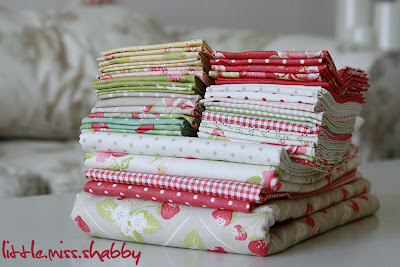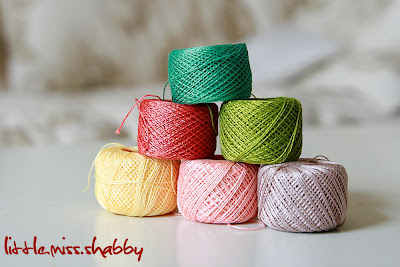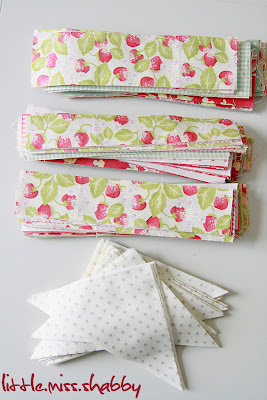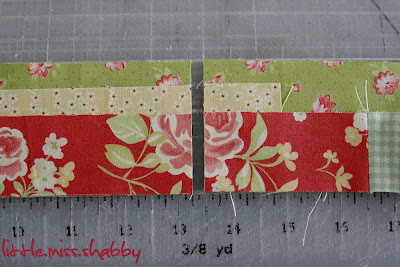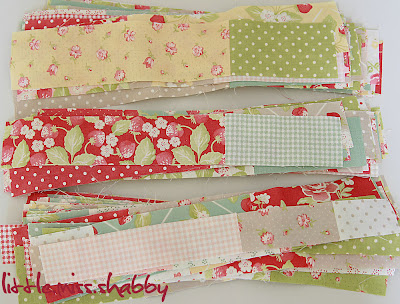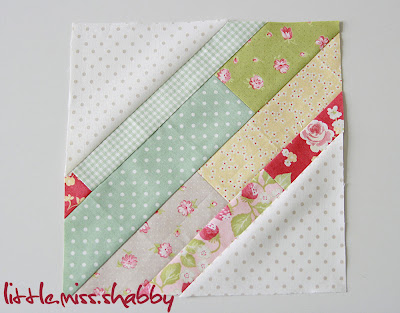
I can’t tell you how excited I am to be back to share with you all a fun quilt made using none other than the Fig Tree Quilts line of fabric, Strawberry Fields. I always love Joanna’s lines of fabric for Moda but I’ve gotta admit that this line is one of my favorites! And I am so in love with this quilt! At the end of this tutorial I’ll show you two alternate layouts that completely change the look of the quilt–but all three quilts are made using one simple block.
I am so excited that Leah from Burgundy Buttons is offering an adorable Framed In quilt kit. We all know how cute these are! So, if you love this quilt as much as I do be sure to snatch up your kit! =)
After you have finished looking over my tutorial, I would love if you would pop over onto my blog at Little Miss Shabby. I have another quilt tutorial posted for a great quilt you can make using the leftover fabric from this quilt. Enjoy!

| 1.25 yd. Ivory Beige Polka 20166-15 |
| 1.25 yd. Lg. Floral 20162-13 |
| .75 yd. Red Gingham 20164-11 |
| 4 yd. Backing 20160-15 |
| .5 yd. Binding Red Polka 20166-21 |
| 1 Fat 8th Bundle Strawberry Fields |
-A 9″ Square piece of template plastic to square up your blocks

I chose to hand quilt my quilt–any of the layouts work beautifully for hand quilting. If you’d like to hand quilt your quilt as well, you may wish to pick up some of the following Finca Perle Cotton (I used size 8). A 10 gram ball of each is perfect.
1137–Yellow
1247–Red
1474–Pink
4812–Green
4350–Aqua
8017–Taupe

All seam allowances are 1/4″.
Begin by giving all of the fabrics in your fat 8th bundle a nice pressing. Ironing wonderful new fabrics is always so much fun; way better than ironing clothes! =) It’ll also provide you with better accuracy as you begin cutting the strips for your blocks.
Now you are ready to begin cutting the strips.
We will be cutting the strips along the short side of the fat eighth–so your strips will be 9″ long–do not cut them along the 22″ side.
Cut the following from each fat eighth:
2 strips 2.5″ x 9″
2 strips 2″ x 9″
3 strips 1.5″ x 9″
Cut the following from the Beige Polka Dot:
6 strips 5.75 x WOF (width of fabric)
subcut into (36) 5.75″ squares & then cut in half diagonally once to make 72 triangles
We are now going to sew our strips together. First, cut a small amount off of 1 strip of each size–a different amount for each width. This way we won’t have to worry about our seams lining up when we sew our strip sets together.
Now we will start sewing together our strips–sewing same width strips to same width strips.
After sewing together several strips, iron seams to one side and trim the set to 13.25″. Using the small pieces (you can see them pictured up above on the right side of the cut), continue sewing more strips together, stopping every so often to trim them down to 13.25″ and then keep going–always utilizing the whole strip.
Continue sewing together the strips and trimming to 13.25″ until you have sewn/trimmed all of the strips. You will have twice as many 1.5″ strips–you will use two of them per block & only one per block of the 2″ width and 2.5″ width.
Now we will sew together four strips to make a rectangle strip set measuring 6″ x 13.25″. Each rectangle block will consist of (1) 2″ x 13.25″ strip, (1) 2.5″ x 13.25″ strip, & (2) 1.5″ x 13.25″ strip. Place the different widths randomly within the block. You want them all to be different, scrappy, and fun.
Continue sewing together the strips until you have a total of 36. Press seams to one side. As you start sewing the last few blocks, you may find that you need a few extra 1.5″ strips–just trim down some of the wider strips as you should have extra of those. =)
To make the corner trimming template, cut a paper square 3″ and then cut diagonally once to make a triangle. Tape the diagonal edge of the paper triangle to your rotary cutter as pictured and trim off each corner of each strip set rectangle.
We will now sew our corner triangles onto our strip set unit.
The triangle unit will extend beyond the strip set unit as shown. Sew together using a 1/4″ seam allowance as pictured.
Press seams and voila! =) Continue to finish all 36 blocks.
Now, these are some stretchy little blocks due to all of the bias edges and can very easily get ironed out of whack. =) Because of this, I chose to square up my blocks before going any further. To make a great template, take your 9″ piece of template plastic and draw a line diagonally from each corner forming an “x”. Take a few of your finished quilt blocks and measure the width of the strip set in the middle (it should be 5.5″–if it is slightly larger or smaller, use your measurement). Divide that measurement in half (if your measurement was 5.5″ that would be 2.75″). Using this measurement draw a parallel line that distance from each side of one of the diagonals you made on the template initially–for example, 2.75″ on each side of the diagonal.
You can use this template to square up all of your blocks–just line up the center strip set with your template and trim. =) You will now have (36) wonderfully square 9″ blocks.
And now the fun part, deciding which layout you prefer:
This is the one that I chose–but, you could also go with a fun zig zag:
Or, this fun little number:
Once you have decided on your layout, sew together the quilt blocks accordingly.
Borders:
From the Red Gingham, cut 6 strips 2.5″ wide x WOF. Sew the strips together, press seams open and cut two strips 54″ long and two strips 58″ long. Sew to quilt top.
From the Floral cut cut 6 strips 4.5″ wide x WOF. Sew the strips together, press seams open and cut two strips 58″ long and two strips 66″ long. Sew to quilt top.
Your quilt is now ready to layer, quilt, and bind. =) You will have extra fabric leftover–who doesn’t love extra fabric?!? This quilt would be very easy to make larger if you wanted to by simply adding more quilt blocks or pop on over to my blog for another fun quilt to make with your leftover goodness (sneak peek below).

One fun, summery, perfect for a picnic, quilt measuring approximately 66″ x 66″.
Corey Yoder
{Little Miss Shabby}





























































































































